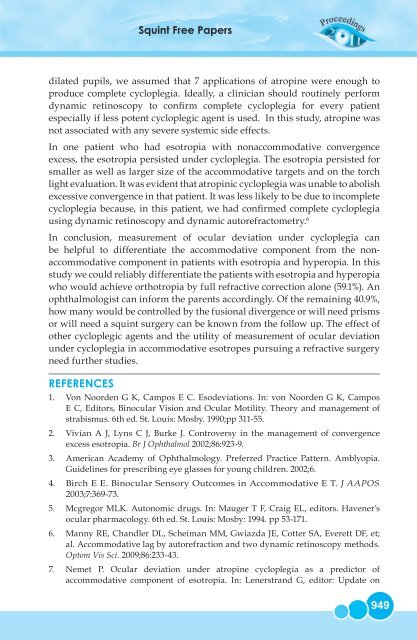Squint Free Papers - aioseducation
Squint Free Papers - aioseducation
Squint Free Papers - aioseducation
You also want an ePaper? Increase the reach of your titles
YUMPU automatically turns print PDFs into web optimized ePapers that Google loves.
<strong>Squint</strong> <strong>Free</strong> <strong>Papers</strong><br />
dilated pupils, we assumed that 7 applications of atropine were enough to<br />
produce complete cycloplegia. Ideally, a clinician should routinely perform<br />
dynamic retinoscopy to confirm complete cycloplegia for every patient<br />
especially if less potent cycloplegic agent is used. In this study, atropine was<br />
not associated with any severe systemic side effects.<br />
In one patient who had esotropia with nonaccommodative convergence<br />
excess, the esotropia persisted under cycloplegia. The esotropia persisted for<br />
smaller as well as larger size of the accommodative targets and on the torch<br />
light evaluation. It was evident that atropinic cycloplegia was unable to abolish<br />
excessive convergence in that patient. It was less likely to be due to incomplete<br />
cycloplegia because, in this patient, we had confirmed complete cycloplegia<br />
using dynamic retinoscopy and dynamic autorefractometry. 6<br />
In conclusion, measurement of ocular deviation under cycloplegia can<br />
be helpful to differentiate the accommodative component from the nonaccommodative<br />
component in patients with esotropia and hyperopia. In this<br />
study we could reliably differentiate the patients with esotropia and hyperopia<br />
who would achieve orthotropia by full refractive correction alone (59.1%). An<br />
ophthalmologist can inform the parents accordingly. Of the remaining 40.9%,<br />
how many would be controlled by the fusional divergence or will need prisms<br />
or will need a squint surgery can be known from the follow up. The effect of<br />
other cycloplegic agents and the utility of measurement of ocular deviation<br />
under cycloplegia in accommodative esotropes pursuing a refractive surgery<br />
need further studies.<br />
REFERENCES<br />
1. Von Noorden G K, Campos E C. Esodeviations. In: von Noorden G K, Campos<br />
E C, Editors, Binocular Vision and Ocular Motility. Theory and management of<br />
strabismus. 6th ed. St. Louis: Mosby. 1990;pp 311-55.<br />
2. Vivian A J, Lyns C J, Burke J. Controversy in the management of convergence<br />
excess esotropia. Br J Ophthalmol 2002;86:923-9.<br />
3. American Academy of Ophthalmology. Preferred Practice Pattern. Amblyopia.<br />
Guidelines for prescribing eye glasses for young children. 2002;6.<br />
4. Birch E E. Binocular Sensory Outcomes in Accommodative E T. J AAPOS<br />
2003;7:369-73.<br />
5. Mcgregor MLK. Autonomic drugs. In: Mauger T F, Craig EL, editors. Havener’s<br />
ocular pharmacology. 6th ed. St. Louis: Mosby: 1994. pp 53-171.<br />
6. Manny RE, Chandler DL, Scheiman MM, Gwiazda JE, Cotter SA, Everett DF, et;<br />
al. Accommodative lag by autorefraction and two dynamic retinoscopy methods.<br />
Optom Vis Sci. 2009;86:233-43.<br />
7. Nemet P. Ocular deviation under atropine cycloplegia as a predictor of<br />
accommodative component of esotropia. In: Lenerstrand G, editor: Update on<br />
949

















